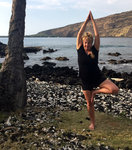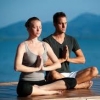In Tree Pose, Take Root to Rise

The yoga pose is not the goal.
Breath by breath, we unveil the layers of protection we’ve built around the heart. Moment to moment we appreciate the body and become aware of the mind and the noise it creates. We make peace with who we really are. Shift your focus and your heart will grow.
Yoga is more than a workout. It’s also a work-in. Tree Pose invites us to center on the heart’s intelligence, feel our roots and stand tall. From a stable core, we rise like a tree, sending out branches and leaves to feed on light and serve the forest.
Because it brings all the richness of biological life into an ideal form, Tree Pose – Vrksasana — (vrik-SHAHS-anna) – celebrates our deep affinity with nature. The tree is a perfect living thing, providing oxygen for air, shade for comfort, wood for lodging, fire for warmth and fibers for cloth.
Trees extend their roots as wide and deep as their canopies and stretch in all directions for their long lives, converting the life force into seeds, nuts and flowers that feed, adorn and astonish us.
Steps to Tree Pose
Whether you can balance on one foot or not, begin near a support for your hand – a table or back of chair – for stable alignment before adding the challenge of balance.
STEP ONE: Remember your roots
Stand up and press parallel feet into the ground a few inches apart. Lift up through your body. Take a few deep breaths, sensing your place in the world. The big and pinky toes and the two sides of the heels press into the earth. The arches of the feet lift like a trunk emerging from the ground. This forms the root of the kinetic chain that allows us to rise taller. As we engage our thighs and our knee caps rise, the kinetic chain works up the body.
STEP TWO: Explore the tree
Imagine your tailbone extending down towards the ground at the same time as the top your head rises toward the nourishing rays of the sun. Inhale, drawing energy from the earth up through your roots, like sap rising in a tree trunk, all the way to the crown. Exhale, sending tension, toxins and distractions down the body and through the feet to be absorbed by the earth. Root down to rise up.
Lift the skin of the legs upward. Firm the side hips in. Draw the legs toward each other and hollow the belly back and up toward the roof of the mouth. Steady shoulders over hips and align head over chest, pelvis and legs. Relax the eye gaze, looking in as much as outward.
Put your right hand on a chair or wall. Bring strength to the right leg and raise the left foot off the ground. Keep the left sitting bone level with the right. Press the left sole to the inside of your right thigh, toes pointed down. Avoid stress on the knee joint: make sure your foot is either above or below the knee. Feel your inner balance.
STEP THREE: Go out on a limb
Place the hands on the hips. Then breathe your palms together at the heart. At your own pace, lift your hands up overhead, either with the palms together, or arms spread apart. Relax shoulders and jaws with crown of head directly above the chest, pelvis and right foot. Breathe slowing and deeply to expand your inner body.
STEP FOUR: Find your small dance
Focus on a point a few feet in front of you. Feel your body make little adjustments to maintain balance, a “small dance” between you and gravity.
The upswept arms, branches of your inner tree, can form cathedral hands: index fingers and thumbs point up while middle, ring and little fingers interlace, palms together. Hands can root into each other just as the feet are rooting into the ground, making micro-movements that inspire greater balance. Feel your “treeness” for five breaths.
Do the pose on the opposite leg.
Enjoy the view
Ironically, the Tree Pose helps us to slow down the mind quickly, as single-pointed focus on balance brings clarity and peace. We strengthen the leg bones, tendons and ligaments while stabilizing the pelvis. It improves our mood and outlook, but in Tree Pose, we are not just emulating a tree.
Ashtanga yoga – meaning “eight-limbed” – has eight branches. At its base are the yamas and niyamas, ethical guidelines for peaceful living. These lower limbs come before the third limb of asana, the postural practice we often associate with mainstream yoga. No matter how we contort our bodies or how long we meditate, we must stay true to yoga’s peaceful roots if we are to live a yoga lifestyle.
Some biologists suggest that the symbolic world tree is programmed into the human mind by evolutionary biology. Human beings are primates and lived in trees for around 60 million years. The idea of a vast tree as the entirety of the world is still implanted in our collective unconscious. Since climbing trees probably saved our ancestors when they were being chased by tigers and wooly mammoths, trees offer comfort like nothing else on earth.
If we send our roots deep, there is no limit to how gracefully we can rise.
RESOURCE:
Burkert W (1996). Creation of the Sacred: Tracks of Biology in Early Religions. Harvard University Press. ISBN 978-0-674-17570-9.
CONTACT:
Contact Dr. Marya Mann here: www.maryamann.com/contact-us
Marya Mann, PhD, co-author of Healing Our Planet, Healing Our Selves, teaches Evolutionary Flow Yoga seminars and classes in Kealakekua, works as an Energy Medicine Specialist at Kona Coast Wellness and Creative Arts Center and leads workshops with ArtWavEs Nourish the Children.


